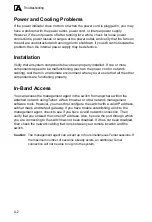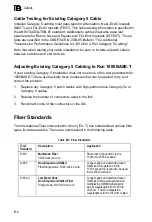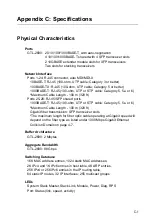
Glossary
Glossary-2
Auto-Negotiation
Signalling method allowing each node to select its optimum operational mode (e.g.,
speed and duplex mode) based on the capabilities of the node to which it is
connected.
Bandwidth
The difference between the highest and lowest frequencies available for network
signals. Also synonymous with wire speed, the actual speed of the data
transmission along the cable.
Collision
A condition in which packets transmitted over the cable interfere with each other.
Their interference makes both signals unintelligible.
Collision Domain
Single CSMA/CD LAN segment.
CSMA/CD
CSMA/CD (Carrier Sense Multiple Access/Collision Detect) is the communication
method employed by Ethernet, Fast Ethernet, or Gigabit Ethernet.
End Station
A workstation, server, or other device that does not forward traffic.
Ethernet
A network communication system developed and standardized by DEC, Intel, and
Xerox, using baseband transmission, CSMA/CD access, logical bus topology, and
coaxial cable. The successor IEEE 802.3 standard provides for integration into the
OSI model and extends the physical layer and media with repeaters and
implementations that operate on fiber, thin coax and twisted-pair cable.
Fast Ethernet
A 100 Mbps network communication system based on Ethernet and the CSMA/CD
access method.
Full Duplex
Transmission method that allows two network devices to transmit and receive
concurrently, effectively doubling the bandwidth of that link.
Gigabit Ethernet
A 1000 Mbps network communication system based on Ethernet and the CSMA/CD
access method.
Summary of Contents for GTL-2690
Page 2: ......
Page 4: ......
Page 18: ...xiv Figures ...
Page 26: ...Introduction 1 8 1 ...
Page 34: ...2 8 Network Planning 2 ...
Page 44: ...3 10 Installing the Switch 3 ...
Page 56: ...A 4 Troubleshooting A ...
Page 62: ...B 6 Cables B ...
Page 73: ...Index Index 3 V VLANs routing 2 6 tagging 2 5 W web based management 1 2 ...
Page 74: ...Index Index 4 ...
Page 75: ......









































